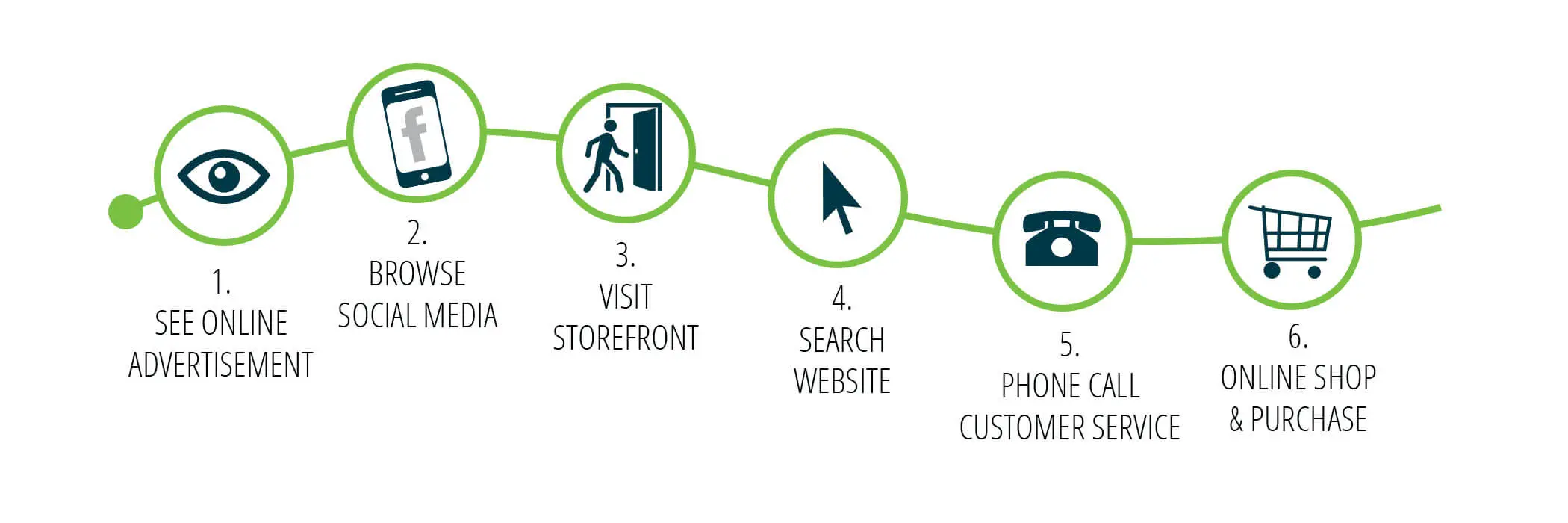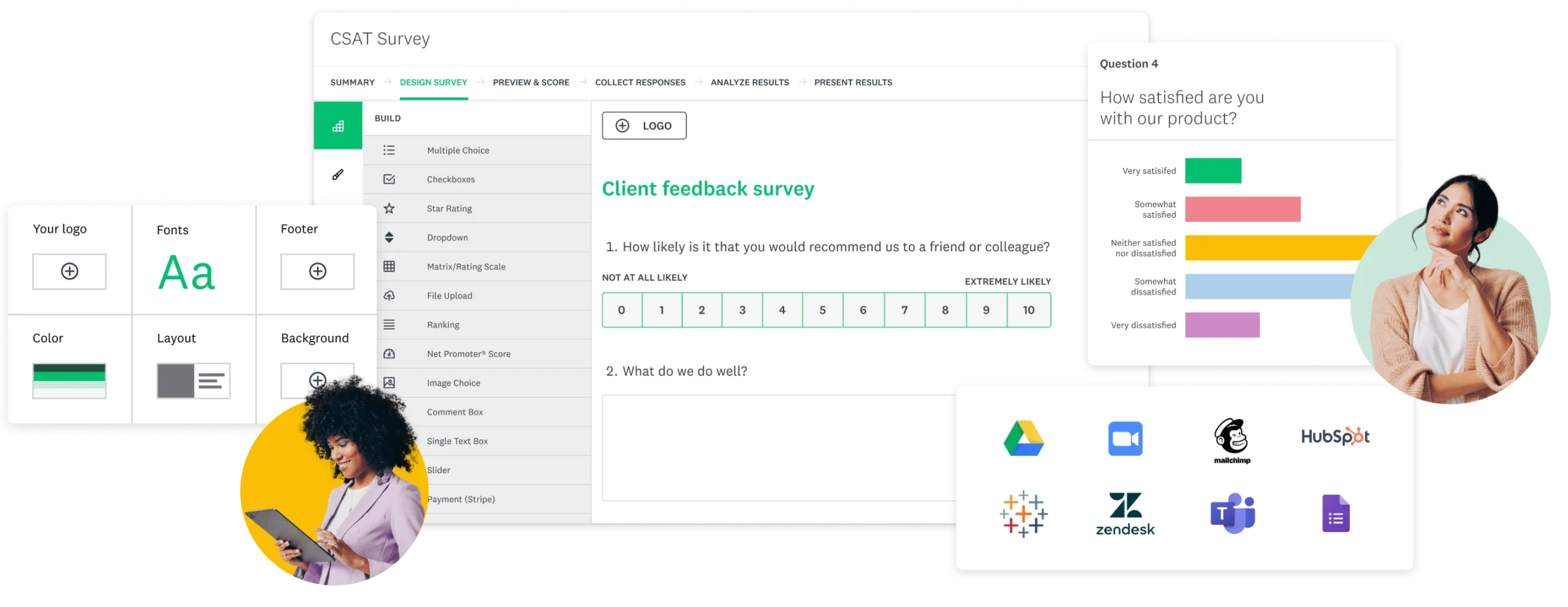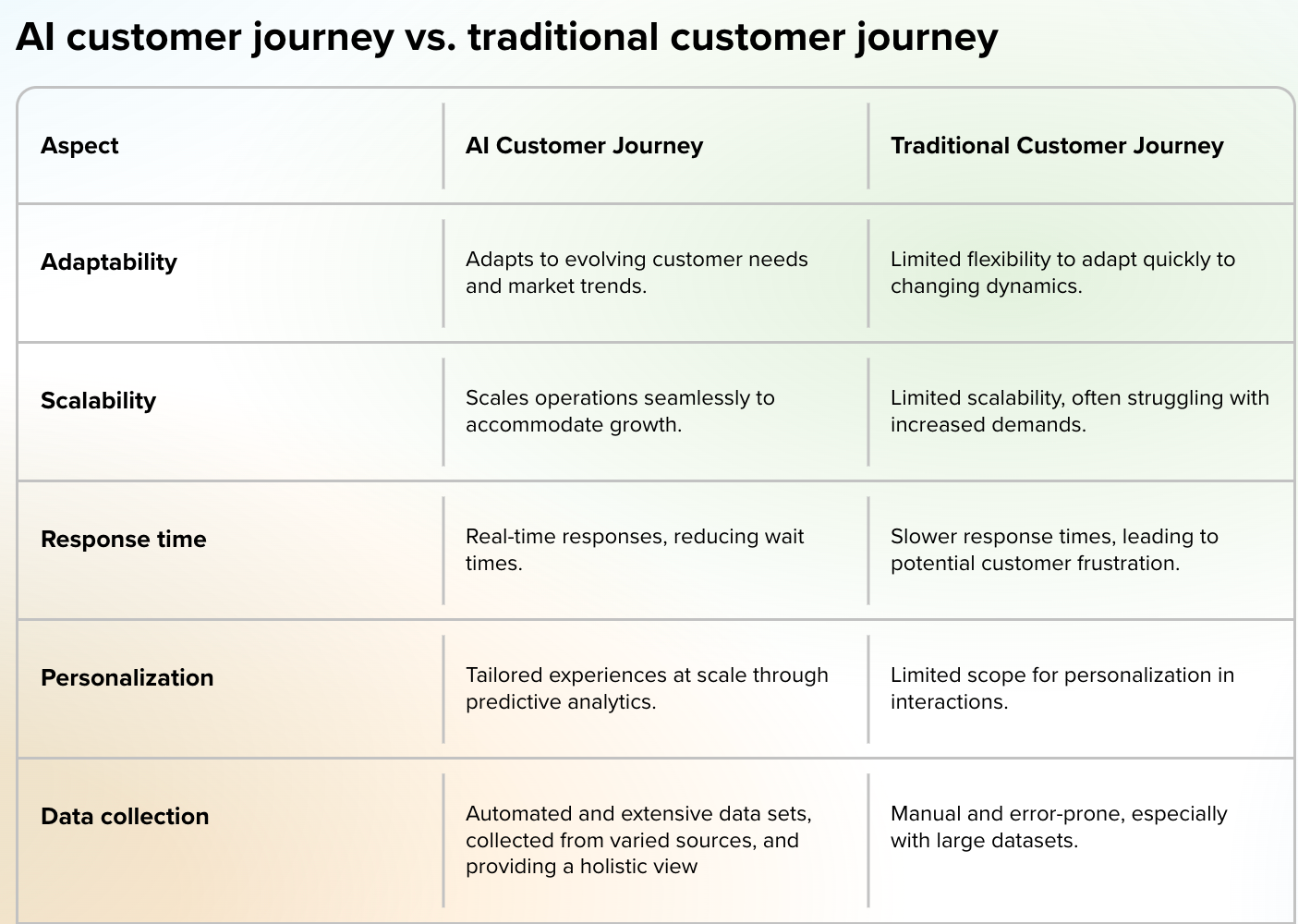Welcome to the future of customer engagement.
Imagine orchestrating your entire customer lifecycle as a well-rehearsed symphony. Just as each section of an orchestra contributes to the overall musical piece, understanding each step of the customer journey provides a detailed and harmonious perspective of your buyer’s experience.
Sound challenging? In reality, it’s not.
It’s 2024, and customer journey mapping has evolved from a niche marketing tool into a standard business practice. Through this powerful resource, you’ll gain an in-depth understanding of the customer journey’s stages, as well as effective tips and techniques for constructing effective journey maps. By the end of this guide, you’ll be conducting your own customer engagement symphony with grace and confidence. Let’s march to the beat of success together.
Mastering the Art of Customer Journey Mapping in 2024
- Decode the fundamentals of customer journey mapping.
- Discover its relevance in comprehending customer behaviour and enhancing their experience.
- Travel through time to understand how customer journey mapping evolved up to 2024.
Understanding the Basics of Customer Journey Mapping
Customer journey mapping is the blueprint of your customer’s experience with your business. Done right, it offers a profound understanding of how customers interact with your business.
For starters, customer journey mapping, in simplest terms, means documenting the entire experience of a customer across multiple touchpoints, right from discovering your product or service, considering it, purchasing it, using it, to maintaining a relationship with your brand.
Its significance in grasping customer behaviour and enhancing their experience is akin to a traveller using a map. Without understanding the path your customers take, your attempts at meeting their expectations and delivering superior experiences might be skewed.
Customer journey mapping enables businesses to view their interactions from a customer’s viewpoint, thereby helping them identify gaps and pain points in the customer experience. This, in turn, aids in making data-driven decisions that foster customer satisfaction and loyalty.

The Evolution of Customer Journey Mapping
The art and science of customer journey mapping have come a long way. If we travel back in time, our understanding of customer journey mapping was rudimentary compared to how it’s understood and implemented today.
The evolution of customer journey mapping is a captivating journey in itself. From simple flow charts and diagrams to complex data visualization and AI predictions, the path has been vibrant and tech-driven.
The technology revolution fueled by AI, machine learning, and automation has reshaped customer journey mapping in 2024. Businesses today have the potential to utilize real-time data and predictive analytics to create more precise and personalized customers journey maps.
The recent advancements in customer journey mapping are fascinating. To name a few:
- AI-enabled predictive modeling
- Omnichannel touchpoints mapping
- Personalized communication modules
These advancements have revolutionized customer experience and have set new standards for businesses worldwide to follow.
The journey of customer mapping is integral to understanding and serving your customers efficiently. It’s an exciting journey where the roadmap gets interestingly intricate and detailed, with each passing year.

Step-by-Step Guide to Creating a Customer Journey Map
- Learn how to define personas and their role in journey mapping.
- Discover the touchpoints that shape the customer journey.
- Understand how to map the customer journey using these touchpoints.
- Learn how to analyze and interpret the customer journey map to pave the way for better customer experiences.
Step 1: Define Your Personas
When mapping customer journeys, personas are instrumental. These semi-fictional representations of your ideal customers form the basis for the journey mapping process.
A persona is essentially a thumbnail sketch of your customer that encapsulates their:
- Demographics: Consider customer demographics such as age, gender, geographic location, income level, education level, and employment status.
- Behavior patterns: Examine how your customers engage with your business, what channels they use, and how frequently they interact.
- Motivations and pain points: Identify what drives your customers – their goals, aspirations and challenges. This information will be crucial when refining your product or service offerings.
By crafting detailed personas, you can better understand who your customers are, what they want, and how they engage with your business.
Creating accurate personas requires a keen understanding of your customers. This involves a blend of market research, customer feedback, and insights gleaned from your customer service and sales teams.

Step 2: Identify Touchpoints
Customer touchpoints serve as critical checkpoints in the customer journey. They represent the various ways your customers interact with your business at each stage of the buyer’s journey.
Identifying these touchpoints depends on a deep understanding of your customer’s journey and which avenues they utilise at each stage. These might include digital touchpoints such as:
- Emails
- Social media interactions
- Website visits
Or physical interactions like customer support calls or in-store purchases.
Understanding your customers’ interactions at each stage allows you to enhance their experiences and, in turn, your business’ growth and success.

Step 3: Map the Customer Journey
Mapping the customer journey involves visually illustrating how customers interact with your business through various touchpoints.
- Start by plotting out each of the persona’s touchpoints in chronological order, from the initial point of contact through the purchasing process and beyond.
- Note their mindset at each touchpoint and where they are interacting with your business (social media, emails, etc.)
The aim is to see the journey through your customers’ eyes and identify potential areas to improve.
Step 4: Analyze and Interpret the Map
Once the customer journey map is complete, it’s time to analyze it. Assess the customer experience at each touchpoint and identify areas where customers may experience friction. Important things to look out for include:
- Big gaps in the map
- Missed opportunities
- Positive experiences
- Where most touchpoints occur
This analysis can provide actionable insights to drive strategy and decision-making.
Leveraging Tools for Effective Customer Journey Mapping
- Efficient tools to help with customer journey mapping and their features
- Vital tips on choosing the suitable tool for your business
Overview of Tools for Customer Journey Mapping
Notable advancements are made in the realm of customer experience. Tools are now developed to simplify the customer journey mapping process, each presenting its unique features and benefits. Below are just a few that we recommend, but do some searching for yourself to find the perfect solution for your business:
- Google Analytics: This web analytics tool spotlights engagement metrics and breaks down exactly how your audience behaves when they visit your site.
- SurveyMonkey: Surveying your target customers helps gauge customer satisfaction. After all, what can you trust more than what your audience is saying?
- Salesforce: This CRM tool is a one-stop shop for connecting with your audience and gaining a deeper understanding of your ideal customer.
- Lucidchart: For the physical side of customer journey mapping, Lucidchart offers intelligent diagramming to visualise your map.

Choosing the Right Tool for Your Business
As the business landscape differs uniquely for companies, choosing the right tool is crucial to effectively map the customer journey.
Identifying Business Needs and Goals
Before diving into the sea of tools in the market, identifying your business needs and goals is crucial. You must be clear about whether you aim for:
- Increased customer engagement
- Lesser churn rates
- Better customer feedback
- Or more effective marketing strategies
Each goal will necessitate a different roadmap, influencing your choice of tools.
Evaluating the Tool
Once business needs are identified, you must evaluate potential tools based on these needs. Look for features such as:
- Usability
- Compatibility with existing tools
- Ability to handle data
- Flexibility
- Cost-effectiveness
Each tool is developed to suit different needs. So make sure to choose the one that complements your objectives and budget.
By leveraging these tools effectively, businesses can craft a detailed and efficient customer journey map, leading to happier customers and successful business growth. Embark on this journey by choosing the suitable toolkit and prepare to be surprised at the insights and growth opportunities you uncover.
Analyzing and Improving Customer Experience with Journey Mapping
- The act of analyzing customer journey maps drives business-improvement decisions.
- Tailoring customer experience, based on journey map analysis, creates better engagement.
- Practical techniques can streamline the process for enhanced consumer experience.
The Role of Analysis in Customer Journey Mapping
Unraveling customer journey maps is a significant step for businesses to tailor strategies and respond effectively to the customer’s needs. It’s not just about recognizing the customer’s touchpoints, but it goes deeper into deciphering why consumers behave the way they do and what ignites or strips their interest. Remember, every actionable plan starts with solid data analysis.
Analysis is pivotal to understanding the existing consumer experience. Palpable transformations lurk within the labyrinth of customer insights, waiting to be discovered and brought into action. When you understand where the customer stumbles, how they bounce back, or why they abandon the journey, it empowers you to turn the tide and design a more consumer-friendly experience.
Switching gears towards improving the customer experience, data collected from the journey maps shows the strengths and weaknesses in your customer interactions. A meticulous understanding of these interactions helps businesses to navigate customer concerns, leading to improved loyalty and satisfaction.
Practical Tips for Improving Customer Experience
Carving out an exceptional customer experience is not a one-size-fits-all approach. However, there are strategies that have proven effective across various businesses. A simple way is to ensure that your customers feel heard and valued. Introduce feedback collection points at various stages of their journey. This ensures that you are equipped with actionable insights to enhance their experience.
Utilizing Feedback for Experience Enhancement
While feedback collection is essential, successful implementation is key. Follow these three tips:
- Receptive attitude towards negative feedback: This openness catalyzes necessary changes and redesigns in the customer journey process, taking customer satisfaction to new heights.
- Personalization: Everyone loves feeling unique and taken care of, and strategies that cater to individual customer preferences significantly augment their experience. Personalizing your communication messages, offers, and even the products or services you recommend embeds a level of comfort and familiarity which means a lot to the customer.
- Simplification: The less effort a customer has to put in to navigate your product or service, the more satisfactory their experience. Whether it is your website design, product features or customer service, ensure the customer journey is smooth, intuitive and user-friendly.
The Future of Customer Journey Mapping
- Predicted trends and advancements that could redefine the customer journey mapping landscape.
- How businesses can position themselves to exploit these new trends and stay ahead of the curve.
Predicted Trends in Customer Journey Mapping
In the ever-evolving world of customer experience, journey mapping continues to take center stage. But what might it look like in the near future?
- AI and machine learning: Artificial intelligence could well become an integral part of customer journey mapping. It offers the potential to process and interpret vast amounts of data to find patterns and predict customer behavior. This could result in more precise and personalized customer journey maps that foster increased customer satisfaction.
- Virtual reality (VR) and augmented reality (AR): These technologies could offer immersive ways to visualize and interact with customer journey maps. These cutting-edge technologies could enable businesses to observe the customer journey from new perspectives, potentially leading to greater empathy and more effective strategies.

Preparing Your Business for the Future of Customer Journey Mapping
Securing a competitive edge in the future means preparing for it today. Here are some steps your business can take to embrace the future of customer journey mapping.
- First, set the foundation by investing in skills and technologies. Building AI and data analysis capabilities is paramount. So is preparing for the adoption of VR and AR. This will allow your business to readily leverage these technologies when they become mainstream in journey mapping.
- Next, create a culture of customer centricity. Embrace the mindset that customer journey mapping is not a one-time project, but rather an ongoing pursuit. This aligns with the likely future trend of increasingly dynamic and personalized journey mapping.
- Finally, don’t forget about the importance of flexibility. With the digital landscape changing at an unprecedented rate, adaptability is crucial. Be ready to unlearn outdated strategies, learn new ones and pivot as necessary.
Ultimately, the future of customer journey mapping may be filled with unknowns, but preparing for these potential trends can put your business in a position to take full advantage of innovative new tools and approaches.
Mapping the Future of Customer Experience
Journey mapping has revolutionized customer experience, by visualizing customer interactions and facilitating strategic improvements. It’s intuitive, data-driven, and results in more satisfied customers. The future of business relies on tailoring every detail to meet customer needs.
Remember, understanding your customers is more than about boosting sales – it’s about fostering relationships. Their journey tells their individual story. Study it.
Now, take our tools, tips, and insights for crafting customer journey maps. Go beyond a simple touchpoint analysis. Dive deeper into your customer’s shoes. Identify the pain points. Discover the moments of delight. Create the best possible experience for your customers.
Question for you: How can you improve one key touchpoint in your customer’s journey today?
“The key to your future success is your customer. Map their journey. Make it unforgettable.”

